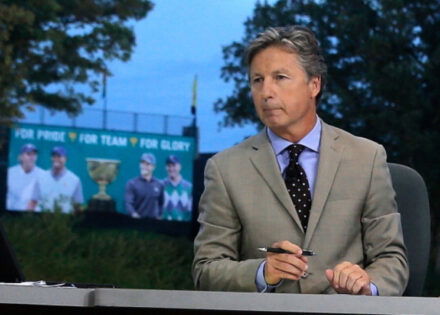At the 2025 KPMG Women’s PGA Championship, rounds stretched past six hours in blistering Texas heat. Par fives played like par sevens, while par fours forced players to lay up, on holes that should’ve rewarded precision iron play. Greens, firm and unreceptive, rejected well-struck shots. Fairways didn’t reward power hitters, and ball-strikers saw no edge. On golf’s grand stage, the finest women golfers in the world weren’t being showcased, they were being squeezed into a format that simply didn’t fit. That setup nightmare, according to one analyst and former LPGA star, was the real culprit behind the tournament’s slow play, high scores, and widespread frustration.
That analyst is Mel Reid: a Solheim Cup veteran, LPGA winner, and now co-host of the golf podcast Quiet Please! With Mel and Kira. Reid, who has become one of the sharpest voices in golf commentary, used her platform during and after the KPMG to take direct aim at what she saw as a chronic issue: course setups that ignore the fundamental differences between the women’s and men’s game. “So, basically, I can’t take all the credit. I actually rang Brandel [Chamblee], um, because I know he does his research. Anyway, I rang Brandel just before I was going on air and I said, ‘Look, we’re going to talk about course setup,’” Reid said on a recent podcast episode.
Chamblee, Golf Channel’s veteran analyst known for his data-backed commentary, gave Reid the statistical backbone she needed. The numbers were clear: LPGA players average 260 yards off the tee, compared to 300 on the PGA Tour. On approach shots, LPGA players hit 7-irons 150 yards versus 180 for men. That 70-yard swing per hole adds up to roughly 1,100 yards of total difference—yet at KPMG, the women’s course was only 240 yards shorter than the PGA Tour’s setup at the Travelers Championship that same week. “Like, it was absurd. And my opinion was that it was course setup,” Reid said.
To Reid, the problem is systemic. Not only are women’s setups failing to reflect differences in distance, height, and spin—but they also lead to dull, overly defensive golf. “Whereas, um, if it was a bit more burnt out at the front, maybe they could have played it a bit better. But it’s just very frustrating, because I’ve said this for years: par fives are way too long, and par fours are too short. And so, it doesn’t actually showcase the talent on the LPGA.” The result, she added bluntly: “Like, it just—it basically is a putting competition every single week. And it’s really frustrating.”
She’s since recalibrated her views—once a proponent of longer, tougher setups, Reid now believes 6,200 to 6,400 yards is the LPGA’s sweet spot. Crucially, she credits Chamblee for showing her how to make her argument stick. “I do have to give a lot of credit to Brandel, because he’s taught me that as well. He’s taught me how to look into it.” Her co-host, golf broadcaster Kira Dixon, chimed in: “And he’s brilliant in the way that he presents his arguments, and it’s so smart of you to lean on him because he’s been doing this for 30 years or something like that.”
Reid’s insights sparked conversation across the golf world. But she wasn’t the only one speaking up.
Top LPGA stars back Reid’s criticism
Reid’s concerns about the 2025 KPMG Women’s PGA Championship course setup didn’t exist in a vacuum. Several high-profile players echoed her frustrations, turning what might have been a one-off complaint into a chorus of discontent. Stacy Lewis, former World No. 1, called out the “absurd” pin placements, especially after storms made the greens even more unmanageable. “There was no way to stop it,” she said of the 8th hole, noting that the setup punished even well-struck shots. “It makes very good players look silly,” she added, language that mirrored Reid’s take.
Angel Yin slammed the layout as repetitive and “boring,” noting that hole strategies barely changed on the back nine. The setup, she argued, robbed players of any creative or aggressive options. Sophia Popov, the 2020 Women’s Open champion, took to social media to support Reid’s analysis. “The @PGA set the golf course up to make us look silly and incapable,” she wrote. Six-hour rounds, brutal wind, and inaccessible pins had reduced one of the season’s biggest events to a grind.
Nelly Korda, the game’s top-ranked player, pointed to the near-impossible pin locations as the biggest cause of slow play and frustration. One of her groups took nearly six hours to finish, with players struggling to hold greens with even their best shots. Even Lexi Thompson, who led after two rounds, called it one of the most stressful weeks she’s endured, while Charley Hull, Reid’s own playing partner, could be seen expressing visible exasperation on the course.
As the LPGA continues to evolve, Reid’s data-backed arguments, and her willingness to name the real issue, are becoming hard to ignore. With the help of voices like Chamblee and the support of fellow players, her call for smarter, fairer course setups is gaining real traction.
The post LPGA Star Credits Brandel Chamblee for Helping Her Call Out Course Setup at Women’s Major appeared first on EssentiallySports.
